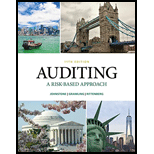
a)
Introduction:Audit risk is the risk thatthe auditor mightdeclare an unqualified report due to his failure in detecting a material misstatement either due to error or fraud.
To state:that the audit risk should be considered at zero level for almost all the audit assignments.
Introduction:Inherent risk is the risk generated by an error or omission in a financial statement because of a factor other than failure of internal control. In a financial audit, inherent risk is most likely to occur when transactions are complex,or when the situations need a high level of judgment for the financial estimates.
To state:That the Inherent risk factor as low as zero level impacts the auditor for not going into detailed examination of the books of account.
Introduction:Control risk is the probability that financial statements are significantly wrong,because of failures in the
To state:That the auditor has to collect evidences on design as well as operations of controls, to assess the control risk at low level.
Introduction:Detection risk is the risk that auditor will not be able detect a misstatement that is found in the decision that could be significant, either individually or collectively.
To state:that detection risk at 50% means that the auditor can rely to the extent 50% about the existence of any material misstatement.
Introduction:Audit risk is the risk that the auditor might declare an unqualified report due to his failure in detecting a material misstatement either due to error or fraud.
To state:That audit risk vary in relation to inherent risk and control risk and has inverse relationship.
Introduction:Audit risk model is a technique which is used by auditors to assess the relationship between various risks generating from an audit assignment, which enables the auditor to manage the overall audit risk.
To state:that judgment of the auditor is a key factor while deciding about the audit risk model.
Trending nowThis is a popular solution!

Chapter 7 Solutions
Auditing: A Risk Based-Approach (MindTap Course List)
 Auditing: A Risk Based-Approach (MindTap Course L...AccountingISBN:9781337619455Author:Karla M Johnstone, Audrey A. Gramling, Larry E. RittenbergPublisher:Cengage Learning
Auditing: A Risk Based-Approach (MindTap Course L...AccountingISBN:9781337619455Author:Karla M Johnstone, Audrey A. Gramling, Larry E. RittenbergPublisher:Cengage Learning Auditing: A Risk Based-Approach to Conducting a Q...AccountingISBN:9781305080577Author:Karla M Johnstone, Audrey A. Gramling, Larry E. RittenbergPublisher:South-Western College PubPrinciples of Accounting Volume 1AccountingISBN:9781947172685Author:OpenStaxPublisher:OpenStax College
Auditing: A Risk Based-Approach to Conducting a Q...AccountingISBN:9781305080577Author:Karla M Johnstone, Audrey A. Gramling, Larry E. RittenbergPublisher:South-Western College PubPrinciples of Accounting Volume 1AccountingISBN:9781947172685Author:OpenStaxPublisher:OpenStax College



